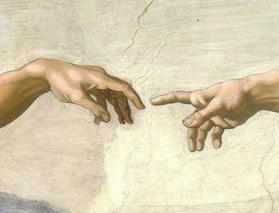So far as Scripture is concerned, the marriage of Adam and Eve was the first, and the last, nude wedding. As soon as Adam sinned, he and Eve made aprons, and later the Lord replaced those with animal skins. Clothing is mercy, hiding the shame of sin. But clothing is also a judgment that institutionalizes the alienation of husband and wife that began immediately after the fall. Clothing protects us from shame, but clothing is also a barrier to intimacy.
In Scripture, clothing is anything but incidental to marriage. Ruth asked Boaz to spread the wing of his robe over her, a token of his intention to marry her. Leviticus describes illicit sex as “uncovering nakedness,” and Ezekiel allegorizes Israel’s history as a romance between Yahweh and his bride, describing how at Sinai Yahweh spread the robe of his tabernacle over Israel. Marriage means sharing a single covering; marriage, we might say, unites a man and woman within a single skin. Between a husband and wife, there is no barrier of clothing, no veil to inhibit intimacy. The veil instead surrounds them both, separating husband and wife from everyone else but not from one another.
In this, as in many other ways, marriage and sex anticipate and signify the consummation of all things. The bodily, earthly and historical consummation of marriage is a figure for the heavenly and eschatological consummation. Now, Paul says, we see through a glass darkly. We are betrothed to our husband, united in one flesh, yet still separated by a veil. Someday the veil will be removed, and we shall see face to face, and know even as we are known. In the ecstatic unveiling of marital sex, we see an image of the ecstasy of the bride united in unutterable joy with her husband, enclosed finally in the love of the Triune God who is love.
But, let’s face it, having one person inside your clothes is often more than you can handle. Sharing a covering with someone else leaves you vulnerable in ways that you’ve never experienced, and leaves you at greater risk than anything you have yet faced. By its very design, marriage strips away clothing, removes the fig leaves and the skins that separate husband and wife; at its core, marriage means a return to primordial, prelapsarian, pre-fall nakedness. As two are made one flesh, barriers are withdrawn, masks torn away, and the two who are made one stand exposed before each other in emotional and psychological, as well as physical, nakedness. But you are not Adam and Eve, and this is not a nude wedding. Marriage is by its nature a return to prelapsarian nakedness, but it is not a return to prelapsarian sinlessness. Getting two sinners to live under one covering is often as peaceful a project as putting two cats in a burlap bag, and giving it a good shake.
This makes it clear why marriage cannot survive if it becomes what sociologist Anthony Giddens has described as a “pure relationship.” A “pure relationship” is one that “exists solely for whatever rewards that relationship as such can deliver.” Your relationships with your banker, your co-workers, the cashier at McDonald’s – these are not pure relationships, because you expect something from these relationship besides the relationship itself – financial stability, cooperation on the job, a Big Mac. When you check out at Wal-Mart the last thing you’re looking for is an opportunity to establish a lifelong friendship with the checker. A pure relationship has no external anchors or supports, but depends entirely on the commitment of the parties. Family relations are not pure relationships, because they are rooted in blood and ancestry, and not in sheer will. A pure relationship is about “us,” always about “us,” and only about “us.”
Marriage is today increasingly seen as a pure relationship “initiated for, and kept going for as long as, it delivers emotional satisfaction.” But treating marriage as a “pure relationship” leaves it floating in air and places unbearable burdens on husbands and wives. Because it is not anchored in anything but the will of the partners, a pure relationship depends completely on their trust and trustworthiness. At the same time, a pure relationship breaks the delicate covenant of intimacy and autonomy that defines trust. The telltale sign of a pure relationship is that everyone’s energies are concentrated on self-referential analysis of the relationship: “How are we doing? Is everything going all right? What did she mean by that? And that? And that?” When absolute demands are placed on mutual trust, trust will shortly decay to distrust.
Treating marriage as a pure relationship is relatively new. In earlier centuries, “Marriage was a contract, often initiated by parents or relatives rather than by the marital partners themselves,” and even Protestant churches that deny marriage is a sacrament see marriage as a mystery figuring Christ’s union with His church. Nate and Hannah, your marriage does call you to intimacy with one another that you will never share with anyone, but your marriage is not a pure relationship. It does not depend solely on your will or your mutual trust; it is not the kind of relationship that lasts only so long as you both find it mutually satisfying.
Your marriage is yours, fulfilling your own hopes and dreams. But always remember that it is also the fulfillment of your parents’ hopes and desires, and an intersection of many communities and a knot of stories. You come here as products of your families and your churches, your teachers and your friends, all of which give your individual life-stories their form. Your marriage is no more self-supporting than you yourselves are. It is enfolded and embedded in a myriad of external relationships, surrounded by and supported by ritual and oath and solemn promises before witnesses, who themselves have promised to see to it that your marriage succeeds. The intimacies of your marriage will thrive only with the assistance of those who remain outside the veil. In short, it is not just about you.
This does not, of course, diminish the central importance of trust in marriage. Marriages without trust are painful to see, and even more agonizing to live. But in a Christian marriage trust is never merely or primarily trust in one another. All relationships must be anchored outside; relationships will never be stable if they are merely dual, and marriage cannot survive as the narcissism of looking only at each other. Don’t sit in the two-legged stool; it will fall, and great will be fall of it. Marriages, like all relationships, must be Trinitarian, with trust directed ultimately not to one another, but to a Third who is Himself Three, the Triune God who has mercifully covered you both with the wing of his garment.















